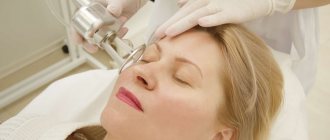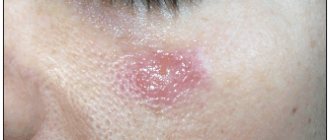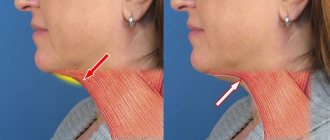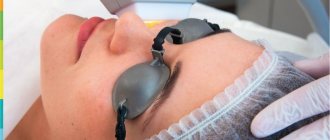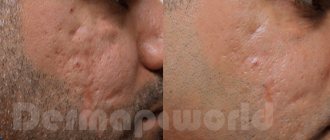The Premium Aesthetics Academy of Cosmetology offers a unique skin rejuvenation procedure using the Fraxel device. You can not only get rid of age spots and any other defects, but also eliminate the first signs of skin aging.
Leave a request
When we offer our patients the Fraxel procedure, the first thing we hear about them is “oh, no, this is a procedure for my mother” (mother-in-law, grandmother - underline as appropriate). In the minds of most, Fraxel is “heavy artillery”, because laser rejuvenation is relevant after 35-37 years.
In fact, the Fraxel device is successfully used for laser peeling in patients over 25 years old. This procedure is ideal for gentle restoration and renewal of young skin. The first wrinkles, signs of post-acne, age spots - these problems cannot be eliminated forever with cosmetic treatments. But Fraxel can do this.
Fraxel fractional laser peeling is a real must-have for those who care about their skin:
Gentle prevention of aging.
Preparing the skin for seasonal stress and rehabilitation after it (sunbathing, sea salt, hot or cold wind).
Aesthetic correction of scars, freckles, rosacea and congestive spots.
Unlike other types of peelings, fractional facial peeling Fraxel not only renews the skin, but changes it qualitatively: the skin becomes radiant, smoother and denser.
Stages of the procedure
The treatment takes place at the Premium Aesthetics Academy. The doctor cleanses the skin and prepares it for laser microbeams about an hour before the start.
Then:
- Anesthesia (special cream) is applied.
- The doctor treats the selected area with the device.
- Finally, a soothing cream is applied to the patient's skin.
The session lasts no longer than half an hour.
After the time interval has passed, the procedure is repeated.
You can discuss with your doctor whether the laser penetrates deeper into the skin or limit yourself to superficial peeling.
The use of Fraxel is absolutely safe for the patient. We are the official distributors of this equipment in Russia, so we guarantee that it has passed all clinical tests and is approved by the FDA.
How it goes
- The fractional laser peeling procedure is performed using an anesthetic cream.
- After a preliminary conversation with the patient about existing problems and studying the characteristics of his skin, the doctor performs makeup removal.
- An anesthetic is applied to cleansed skin and left for 40-60 minutes.
- The patient protects his eyes with glasses.
- The doctor selects the laser exposure parameters, removes the anesthetic, applies a lubricating cream and begins Fraxel peeling.
- When the manipulator touches the skin, fractional destruction of defective cells occurs, the patient feels warmth and a slight burning sensation.
- Facial treatment lasts on average 20-30 minutes.
- 20-30% of the skin surface is treated in one session
What it is
Fraxel is a fractional photothermolysis technique. The laser is used to accelerate the remodeling of skin collagen, which gives it youth and elasticity. Fraxel was first used in hardware cosmetology back in the early 2000s.
Advantages of the laser:
- all these miracles occur without surgical intervention, tension or other artificial skin tightening;
- no scars or other damage remains;
- subsequently nothing sags, as often happens after some unsuccessful cosmetic surgeries.
The Fraxel device uses multiple microbeams to precisely target problem areas. Rays thicker than a human hair form a huge number of micro-impact zones on every centimeter of skin. As a result, microdamages are formed - under the influence of heat, old defective collagen, excess pigment and other elements associated with age are destroyed - but at the same time they are surrounded by healthy tissue. In undamaged cells, the synthesis of collagen and elastin is activated. Thus, thousands of microfactories are activated to produce collagen directly in your skin, which ensures rapid renewal and restoration of the dermis.
Even in one session you can achieve an improvement of 15-30% of the skin, and after completing the entire course - 100%.
Indications
Fractional facial peeling is a soft and delicate skin cleansing procedure recommended for those over 25 years of age with the following indications:
- The first mild signs of photo or chronoaging.
- Initial weakening of skin tone.
- Pigment spots (freckles, melasma).
- dull skin color.
- Uneven microrelief of the skin (shallow scars, post-acne).
- Primary signs of rosacea.
- Enlarged pores, increased oil content.
Types of Fraxel laser
Rejuvenating and healing procedures using the Fraxel laser are performed not only on the face, but also on other areas, including the back, abdomen and limbs. There are several types of Fraxel laser, differing in penetration depth and intensity. Among them:
- Fraxel re:store
is a kind of fractional laser standard with a wavelength of 1550 nm. Penetrates the skin within 0.5-1.5 mm and helps get rid of acne and post-acne, sunburn, scars, scars and some signs of skin aging; - Fraxel re:store DUAL
is a combination of thulium and erbium lasers with different wavelengths. This is a more advanced procedure compared to Fraxel re:store. It is used to treat wrinkles and post-acne with varying intensities, removes deep scars and scars, as well as age spots; - Fraxel re:fine
is a laser with a delicate effect on the skin, providing exclusively superficial irradiation due to a wavelength of up to 1420 nm. Despite its low activity, it has a large number of advantages, including use in areas with the thinnest and most sensitive skin (around the eyes, chest area, etc.), as well as a short recovery period after the procedure; - Fraxel re:pair
is the most aggressive laser technique, during which the rays penetrate into the deepest subcutaneous layers. This procedure is used to treat the deepest wrinkles, scars and scars. Effective for oily skin with enlarged pores.
NON-ABLATIVE FRACTIONAL PHOTOTHERMOLYSIS
Rice. 1. Diagram of temperature distribution in the upper layers of the skin. Heating zones in the area of microbeam penetration (future MLZ) are surrounded by areas of normal temperature. As the beam penetrates deeper into the tissue, the amount of transmitted energy and temperature decrease
During the exposure of the skin to the Fraxel re:store laser, so-called micro-treatment zones (MTZs) are formed. MLZ are zones of photothermolysis (photocoagulative necrosis) 70–350 microns wide and up to 1.4 mm deep. MLZ have the shape of cones, perpendicular to the surface of the skin, their density can reach 11,000 MLZ/cm2. The chromophore for Fraxel re:store radiation (wavelength 1550 nm) is mainly water, so coagulation occurs in both the epidermis and dermis; The stratum corneum of the epidermis, which contains little water, is minimally damaged, which allows the barrier functions of the skin to be preserved [2]. At the level of the epidermis, the laser heats the skin to a temperature of approximately 90°C; as it penetrates deep into the skin, the laser radiation loses energy, so in the lower part of the MLZ relative to the skin surface, heating occurs to 45–50°C (Fig. 1).
Since heat from the region of laser-induced heating spreads into the surrounding space, the formed MLZs find themselves surrounded by heat shock zones. In these zones, within 1–3 hours after laser exposure, heat shock proteins (HSP47, HSP70, HSP90), growth factors, interleukins and other signaling molecules are released, which trigger proliferation processes in the epidermis and dermis, activate intra- and extracellular proteolysis and attract immune cells, primarily macrophages, to the damaged area. Necrotic debris in the coagulation zone is partially absorbed by macrophages, partially evacuated to the surface of the epidermis and forms the so-called microepidermal necrotic debris (MEND) [2, 3]. MEND contains destroyed collagen and elastin, as well as a large amount of melanin [4, 5]. Due to the migration and proliferation of epidermal stem cells, the basal layer in the affected area is completely restored after 24 hours. After 7 days, at the site of the MLZ in the epidermis, a normally formed area of tissue without elements of dyskeratosis and spongiosis is found [2].
Proteolysis and phagocytosis of necrotic debris in the damaged area is largely stimulated by mediator signals from the proliferating epidermal cells. Migrating fibroblasts in the initial stage of reorganization of the coagulation focus synthesize collagenase and other proteolytic enzymes. 7 days after the procedure, expression of type III collagen is detected in the dermis; foci of neocollagenesis surround the MLZ and are most pronounced in the areas subject to MLZ [2]. Thus, the process of collagen remodeling involves a microsection of the dermis, which is significantly larger in size than the MLZ. The restructuring of the collagen framework occurs within 2–3 months, which is confirmed by smoothing the skin, reducing the depth of wrinkles and pore size.
CLINICAL APPLICATION OF NON-ABLATIVE FRACTIONAL PHOTOTHERMOLYSIS METHOD USING THE EXAMPLE OF THE FRAXEL RE:STORE PROCEDURE
The process of fractional remodeling, which the Fraxel re:store laser fractional photothermolysis apparatus initiates in the skin, takes place in the epidermis and dermis at a depth of 0.3–1.5 mm, therefore this laser is used to correct a number of aesthetic defects expressed in changes in relief and skin texture.
The main indications for the Fraxel re:store procedure can be divided into three groups:
a) involutional changes in the skin; b) dyspigmentation; c) cicatricial deformations of the skin.
In addition to solving specific problems, such as removing age spots and reducing the size of wrinkles, the Fraxel procedure improves the mechanical properties of the skin, reduces the size of pores and evens out the texture. Selective heating of water and the principle of fractional exposure make it possible to carry out the procedure on almost any area of the face and body, as well as with any phototype on the Fitzpatrick scale, which seriously expands the capabilities of Fraxel in comparison with methods of traditional (non-fractional) laser skin remodeling.
The mechanism for smoothing skin texture under the influence of Fraxel is that all structures in the area of the MLZ are coagulated, including those containing melanin. Newly formed in the process of subsequent remodeling, epidermal cells synthesize and accumulate an adequate amount of melanin, which is clinically expressed in the lightening of age spots and smoothing of skin texture.
The large depth of the formed MLZ allows the destruction of pigment localized on the basement membrane of the epidermis and in the dermis, therefore Fraxel is used in the correction of deep forms of hyperpigmentation, such as melasma [6, 7]. On average, one procedure involves 20–30% of the skin in the treatment area, so significant lightening or complete evening out of skin color in the area of hyperpigmentation should be expected after 3–4 procedures [8].
Coagulation of the dermis to the reticular layer stimulates the renewal of the collagen-elastin framework of the skin, making Fraxel effective in correcting fine wrinkles and enlarged pores [7]. The non-invasiveness of the method, rapid recovery in the affected area and the absence of heating of the underlying tissues make it possible to treat almost any area of the skin [9, 10]. Positive results are achieved using the method of laser fractional photothermolysis in the treatment of scars of various etiologies and localizations [11–15]. Observations show that the surface of the scar is significantly smoothed out after 4–5 procedures, and in 75% of patients positive dynamics are observed after the first treatment session.
PARAMETERS OF NON-ABLATIVE FRACTIONAL PHOTOTHERMOLYSIS PROCEDURE
Based on the description of the processes occurring in the skin during fractional remodeling, a number of parameters of the Fraxel re:store procedure can be identified that can affect its effectiveness and safety. It seems convenient to us to divide these parameters into two groups: the parameters of each MLZ and the parameters of the MLZ distribution over the treated surface.
A. MLZ parameters
Rice. 2. Histological picture of the epidermis and dermis in microtherapeutic zones (MTZ) on the 2nd day after the procedure with exposure to radiation of different energies. It can be seen that with increasing energy, the depth and diameter of the area of coagulation necrosis increase. Staining of sections with hematoxylin-eosin
MLZ depth. The depth of the Fraxel re:store micro-treatment zone ranges from 370 to 1400 microns and directly depends on the energy of the micro-beam (Energy), which in turn is adjustable within the range of 4–70 mJ (Fig. 2). The device screen displays the beam energy and the depth of the MLZ; the doctor selects the energy in accordance with the indications for the procedure (Table 1), the treatment area and the structural features of the patient’s skin. Hyperpigmentation, skin texture disorders and melasma are associated with disruption of the formation and distribution of melanin in the epidermis, therefore, for their effective correction, it is enough to form MLZ at the epidermal level.
Correction of age-related and UV-induced changes in dermal collagen can only be effective when creating MLZ at the level of the reticular layer of the dermis. Correction of hypertrophic scars requires the use of maximum energy.
In some areas of the skin, the anatomical thickness of the epidermis and dermis of which differs sharply from the average values, the energy should be set taking into account the structural features of the skin in these areas. For example, in the area of the mobile eyelid, the energy should not exceed 10 mJ, even if the indication for the procedure is a hypertrophic scar.
Diameter of MLZ. The diameter of the Fraxel re:store micro-treatment zone ranges from 70 to 350 microns. This parameter, like the depth of the MLZ, depends on the energy of the microbeam and can affect the healing process [16]. It is believed that as the diameter of the microdamage increases, the rate of restoration of the basal layer of the epidermis decreases, and when the diameter of the microdamage exceeds 500 μm, this rate drops catastrophically quickly. In addition, observations show that normal neocollagenogenesis during fractional coagulation at the level of the reticular layer of the dermis occurs with MLZ with a diameter not exceeding this value. In addition to the energy of the microbeam, the diameter of the MLZ depends on the temperature of the skin at the site of its formation [17] and on the geometric parameters of the microbeam [3].
The Fraxel re:store fractional laser photothermolysis device uses a system for automatically optimizing the microbeam diameter to achieve maximum coagulation depth with minimal energy. The ratio of MLZ diameter/MLZ depth does not exceed 1/5.
MLZ distribution. The Fraxel laser distributes MLZ over the skin as the working handle moves across the skin, while the tip of the handle must always be in contact with the surface of the skin, and the handle itself must maintain a perpendicular position relative to the plane of the surface being treated to achieve maximum coagulation depth. The act of moving the handle from one boundary of the sector being processed to another is called a pass. During such a pass, Fraxel forms a strip 15 mm wide of the required length, on each square centimeter of which the MLZ are distributed with the same density. The Optical Tracking System (IOTS) ensures uniform distribution regardless of handle speed. Typically, the procedure consists of carrying out several passes over the same place, during which the total density of the MLZ (Total Density) is formed.
The total MLZ density (or MLZ density) is the number of MLZs on each square centimeter of the treated surface, formed during the entire procedure. The percentage of coverage—the percentage of coagulated tissue in the treatment area—directly depends on the density of the MLZ.
The percentage of coverage is the most important parameter of the procedure, on which its effectiveness and safety depend. In fact, percentage coverage is the area of coagulated areas on the surface of the skin divided by the area over which they are distributed. For an average aggressive procedure, the coverage percentage is 20%. This parameter is nonlinearly related to the density of the MLZ and the diameter of the MLZ. The more MLZs are formed and the larger the diameter of each MLZ, the larger the coverage percentage will obviously be.
The effectiveness of the procedure and the rehabilitation period depend on the percentage of coverage. The doctor selects this parameter based on medical history, assessing mainly the ability of the patient’s skin to regenerate, and also based on the patient’s wishes, what should be taken as a priority: the effect of treatment or rapid rehabilitation. It is recommended to use a coverage percentage below 20% when treating melasma, as well as for patients with Fitzpatrick phototypes IV–VI.
Rice. 3. Fraxel re:store treatment levels and corresponding percentage coverage values
Treatment Level . The coverage percentage is adjusted by changing the so-called Treatment Level. There are 15 treatment levels in total, each of which has its own coverage percentage. The first level of treatment is the most gentle, it corresponds to 5% coverage, the 15th is the most aggressive, it corresponds to 48% coverage (Fig. 3).
All adjustable parameters of the procedure are interconnected. This means that changing one parameter automatically changes a number of others. For example, to provide 20% coverage at an energy of 10 mJ, it is necessary to achieve a density of 2000 MLZ/cm2. The MLZ density is calculated automatically (Fig. 4). But with increasing energy, the diameter of the MLZ inevitably increases, so the system automatically reduces the total density of the MLZ, keeping the coverage percentage unchanged.
So, to achieve the same 20% coverage, but with an energy of 20 mJ, the density will be 780 MLZ/cm2. Simultaneously with the change in the total density of the MLZ, the density of the MLZ per pass also changes. It can be concluded that the density of the MLZ is a parameter clinically less important than the percentage of coverage. When changing the energy and level of treatment, the total density of the MLZ can theoretically change from 100 to 11000 MLZ/cm2, while the key for the doctor will remain the percentage of coverage (level of treatment), and the density of the MLZ will be more informative.
Rice. 4. Fraxel re:store laser treated thermal paper. Areas of penetration of the laser beam are visible in the form of white dots, which are distributed over the entire width of the pass made. With increasing energy, the diameter of the points increases and their density decreases, while the total area of all points on each square centimeter in the pass area in sectors 1, 2, 3 and 4 of thermal paper remains the same
Fraxel allows you to accurately control the percentage of destroyed tissue in the area of the procedure, which makes it possible to achieve predictable and reproducible results. At the same time, the risk of possible complications associated with exceeding the coverage percentage is reduced to a minimum. The last parameter that the doctor can change is the number of passes. The number of passes made in the same area can vary from 4 to 16, the average and most often used number of passes is 8. The percentage of coverage does not depend on this parameter, since the system automatically recalculates the density of the multi-layered zone per pass, dividing the total density of the multi-layered zone by the number of passes. So, with a total density of 2000 MLZ/cm2 and the planned 8 passes, passes with a density of 250 MLZ/pass will be formed. If the doctor considers it necessary to plan 16 passes, then the density per pass will already be 125 MLZ/cm2.
Usually the number of passes is adjusted to achieve maximum patient comfort. As the number of planned passes increases, the duration of the procedure increases, but at the same time it is more comfortable for the patient. This parameter is set in advance, but can change, as well as the energy and level of treatment, directly during the procedure.
FRAXEL RE:STORE METHODOLOGY
A. Indications
• age-related skin changes: structural changes in the epidermis and dermis, elastosis, wrinkles, including oral and periorbital, changes in the structure of collagen and connective tissue, enlarged pores (medical technology No. FS 2007/172 dated August 9, 2007); • pigmentation: pigment disorders, lentigo, actinic (solar) keratosis, chloasma; • scars: atrophic and hypertrophic, acne scars, skin stretch marks.
B. Contraindications
• absolute: epilepsy, pregnancy, lactation, psoriasis, cancer, tendency to form keloid scars; • relative: inflammatory processes in the area of intended treatment, chemical peeling and other similar procedures performed less than 2 weeks before treatment, atopic dermatitis in the acute stage.
B. Preparation for the procedure
Preparation for the Fraxel re:store procedure must necessarily include: removing makeup, photographing the patient, applying surface anesthesia 40–60 minutes before the procedure and measuring the area of the treated surface using IOTS and the built-in calculation program. An assessment of the area of the treated surface is necessary to determine the total energy that will be transmitted by the laser during the entire procedure, and can indicate to the doctor possible errors at the time of its implementation.
D. Carrying out the procedure
The Fraxel re:store procedure in the facial area lasts 15–20 minutes, while treating a scar 10 cm long – 5 minutes. During the procedure, the doctor distributes the planned number of passes over the treated area. To control the distribution of passes over the surface of the skin, the so-called Trecking Gel is used - a waterless gel based on mineral oils and polyethylene. The gel leaves a shiny film on the surface of the skin, on which traces of the rollers of the tip of the working handle are imprinted. This allows the doctor to accurately determine the boundaries of each pass and carry out the next pass strictly in accordance with the previous or adjacent pass. There are many different techniques for distributing passes, the description of which is beyond the scope of this article, however, any technique should ensure uniform distribution of MLZ of a given density with maximum comfort for the patient and with precise control of the percentage of coverage.
D. Completion of the procedure
Upon completion of the procedure, the gel and remaining anesthetic cream are removed from the skin, after which Panthenol or Regenerative cream from the SYSTEM nanogreen PROFI cosmetics line is applied. Most patients use this cream during the first three days after the procedure (Fig. 7). Undesirable side effects that can be expected after the Fraxel re:store procedure are less common than after other aggressive procedures (for example, after CO2 laser ablation), and are presented in Table 2.
E. Complications
The most extensive study of the incidence of various complications after the Fraxel re:store procedure to date was conducted by Graber EM et al. based on data on 961 procedures [19]. The most common side effects were acne (n=18; 1.87%), herpes virus infection (n=17; 1.77%), erosion (n=13; 1.35%). Post-inflammatory hyperpigmentation (n=7; 0.73%), prolonged erythema (n=8; 0.83%), prolonged swelling (n=6; 0.62%), dermatitis (n=2; 0.21) were observed less frequently. %), impetigo (n=1; 0.10%) and purpura (n=1; 0.10%). The provided statistical data once again confirms that Fraxel fractional photothermolysis is safer than traditional aggressive methods of laser remodeling of the skin surface.
CLINICAL CASES
In conclusion, we present two clinical examples of the use of Fraxel re:store. Since the number of publications and reports on the clinical use of this laser is quite large, we find the most interesting results of Fraxel treatment in situations where the use of traditional treatment methods is ineffective or difficult. Materials kindly provided by Dr. Oleg Sheptii (TelosBeauty High Technology Clinic, Moscow).
1. Treatment of hypertrophic scars
Patient V., 35 years old. Post-traumatic scars in the forearm (inner surface) 19 years ago. Note. Typically, 6–7 procedures are sufficient to correct hypertrophic scars; the patient wished to continue treatment after the 7th procedure, which allowed us to make the last observation (Fig. 6).
Equipment used: Fraxel re:store laser (Solta Medical Inc., USA).
Impact parameters: energy 2–70 mJ (70 mJ directly in the area of scars, 25 mJ in the area around the scars), treatment level 6–7, number of passes – 8.
2. Treatment of skin stretch marks
Patient A. 42 years old. Striae in the abdominal area, formed after prolonged use of hormonal creams.
Equipment used: Fraxel re:store laser (Solta Medical Inc., USA).
Impact parameters: energy 25–40 mJ. Treatment level 6–7. The number of passes is 8. Since the patient had a history of atopic dermatitis, which is a particular contraindication to the procedure, the first procedure was performed at the minimum parameters for correcting stretch marks of 25 mJ.
CONCLUSIONS
Laser non-ablative fractional photothermolysis is successfully used in aesthetic medicine for the treatment of chrono- and photoaging, smoothing skin texture, removing hyperpigmentation, smoothing surgical and traumatic scars, the consequences of acne, as well as skin stretch marks. The Fraxel re:store laser allows you to perform a non-ablative fractional photothermolysis procedure with a high degree of safety, and thanks to clear control over a number of its parameters, it makes it possible to predict the positive and negative effects of the procedure. The effectiveness, safety and recovery time of Fraxel re:store depend mainly on the energy and level of treatment - parameters of the procedure that are directly related to the depth of remodeling and percentage of coverage.
Rehabilitation
After exposure to the device, the skin will require additional care. For two weeks you need to moisturize it with light, non-greasy products, and for a month you need to protect your skin from ultraviolet radiation. Decorative cosmetics can be used on the first or second day.
Swelling and redness after Fraxel are absolutely normal. These are signs that rejuvenation processes have begun. The renewed skin will begin to peel off within two weeks. The rehabilitation process will be completely completed in a month, and that’s when it’s worth evaluating the results.
Progress of the procedure. During it, the patient feels slight tingling and warmth.
How the Fraxel laser works
With fractional photothermolysis, the skin is rejuvenated and healed at the cellular level, that is, new skin cells are reproduced.
In a simplified way, the procedure can be described as follows: under the influence of a slight temperature shock from the thinnest laser beam, the outlived cells evaporate, and the younger ones begin to actively divide, trying to close the gap that has formed. Skin fibroblasts actively produce elastin and collagen, from which young skin without cosmetic flaws is “built.”
In this case, in general, the top layer does not suffer, since Fraxel works pointwise. Unlike, for example, laser peeling, which acts in a wider “stroke”. The area of influence with Fraxel is very small, and around this area there are many healthy cells, so recovery occurs very quickly (the ratio of damaged and untouched skin is approximately 20% to 80%).
The Fraxel procedure can be performed even at a young age to eliminate skin problems (acne treatment) and eliminate the consequences of acne (post-acne, scars). You can resort to rejuvenation using fractional laser from the age of 25.
1 Fractional photothermolysis in MedicCity
2 Fractional photothermolysis in MedicCity
3 Fractional photothermolysis in MedicCity
After using Fraxel DUAL
Fractional skin rejuvenation gives visible results after the first procedure, however, to consolidate the effect, it is advisable to take a course of several sessions. The duration of the course depends on the severity of cosmetic defects.
By combining fractional rejuvenation with other methods of hardware and injection cosmetology, you can achieve maximum aesthetic results. Biorevitalization, mesotherapy, contouring, Botox injections - these and other procedures will return your skin to a healthy color, smooth out wrinkles and help get a lasting lifting effect.
Rehabilitation period after peelings
The recovery period after chemical peels varies: with superficial peeling it is literally 2-3 days of tightness and slight peeling without much discomfort.
After laser procedures, recovery will be longer - from 3 to 7 days. This is due to the deeper impact and skin area covered. After all the crusts and peeling disappear, the skin will become smooth and beautiful.
Of course, everything is individual, and the skin may react differently: there may be redness, peeling immediately after the procedure, and itching. In these cases, it is important to remember that these are temporary changes that will not affect the final result, but they require careful care and contact a specialist.
Contraindications
- Inflammatory processes in the treated area.
- Epilepsy.
- Pregnancy.
- Malignant formations in the treatment area.
- Psoriasis, atopic dermatitis in the acute stage.
- Less than two weeks after chemical peels or other aggressive procedures.
For all indications and contraindications, you should consult a doctor.
You can make an appointment with a specialist by phone: +7(499) 4901097
Results of the procedure
Prices
Fractional laser rejuvenation Fraxel (Fraxel)
| Fraxel upper eyelids | 8,000 rub. |
| Fraxel lower eyelids | 8,000 rub. |
| Fraxel forearm area | 36,000 rub. |
| Fraxel elbows | 15,000 rub. |
| Fraxel eyelids+periobital area | 15,000 rub. |
| Fraxel neckline | 25,000 rub. |
| Fraxel face+eyelids | 26,000 rub. |
| Fraxel face+eyelids+hands | 31,000 rub. |
| Fraxel face+neck | 35,000 rub. |
| Fraxel face+neck+décolleté | 40,000 rub. |
| Fraxel forehead | 10,000 rub. |
| Fraxel perioral area | 10,000 rub. |
| Fraxel shoulders | 37,000 rub. |
| Fraxel chin | 10,000 rub. |
| Fraxel neck | 17,000 rub. |
| Fraxel cheeks | 15,000 rub. |
| Fraxel post-acne face, excluding eyelid area | 23,000 rub. |
| Fraxel post-acne forehead | 15,000 rub. |
| Fraxel post-acne cheeks | 15,000 rub. |
| Fraxel face (excluding eyelid areas) | 23,000 rub. |
All services
How Fraxel rejuvenation FRAX 1550 works
FRAX 1550 technology is based on the impact of a fractionated diode laser on the dermis to a depth of 1.5 mm, which causes active production of young collagen by fibroblasts. Uniform, controlled damage to the deep layers of the skin triggers a cascade of restoration work that is invisible and at the same time so effective that even from one procedure the increase in effect continues for several months! A pleasant bonus of such rejuvenation will be the correction of hyperpigmentation, narrowing of pores, smoothing out unevenness and scarring of the skin.


